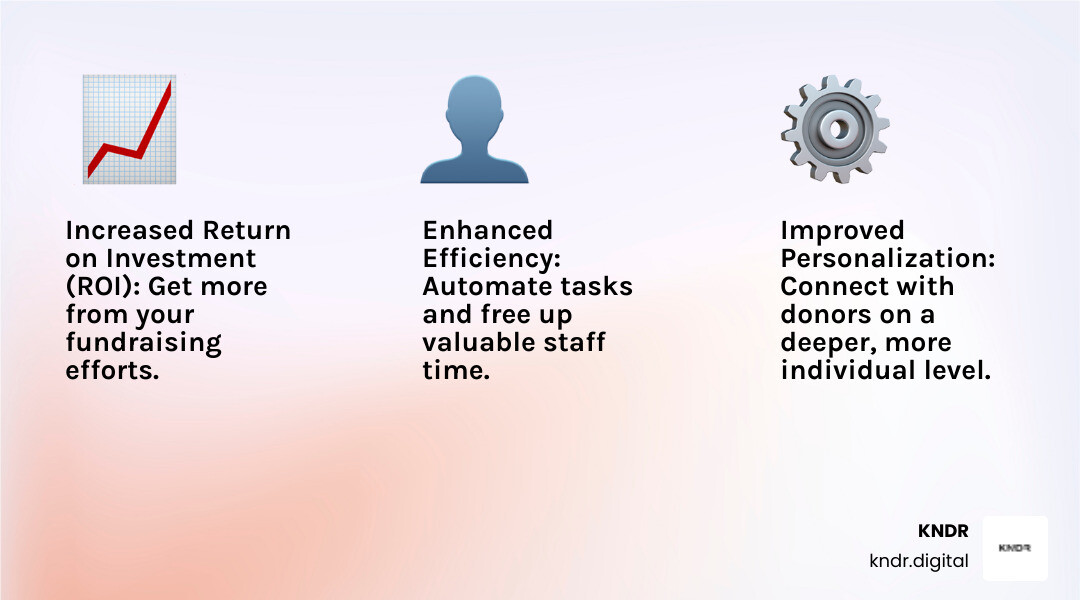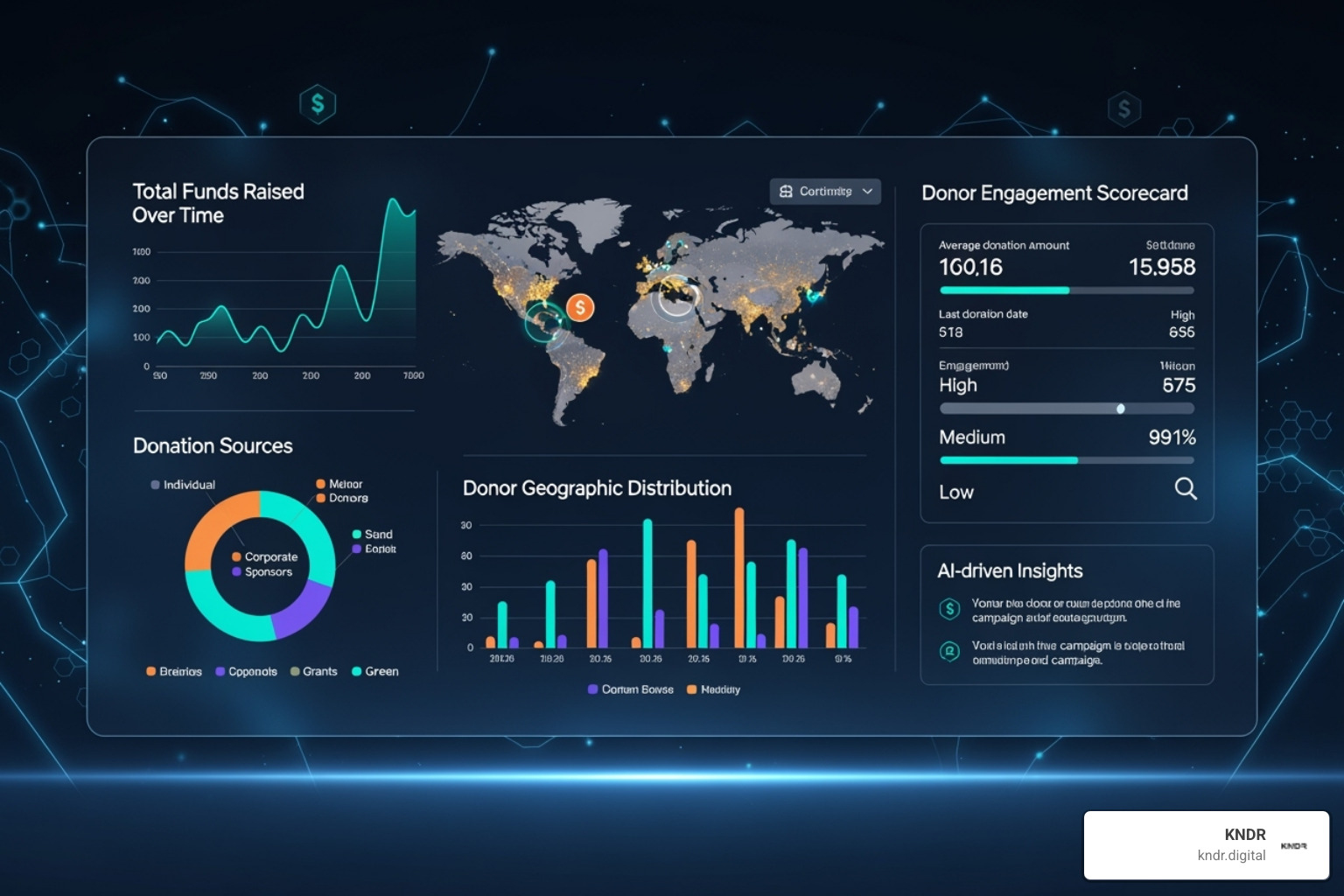How AI-Driven Fundraising Tools Are Revolutionizing Nonprofits

Introduction: The New Era of Philanthropy
AI-driven fundraising is revolutionizing how nonprofits connect with donors and raise money. By using smart technology, it makes fundraising more effective by increasing return on investment (ROI), improving personalization, and boosting efficiency.
For many nonprofit directors, the challenge is attracting new donors and boosting giving without endless work. While old methods often fall short, AI changes the game. It's no longer just for big tech; over half of nonprofits now use artificial intelligence, and 74% of online donors believe nonprofits should use AI for marketing, fundraising, and admin tasks.
AI helps nonprofits move past outdated tools and limited resources, offering a path to better donor engagement and streamlined operations. It's about working smarter, not harder.
I'm Mahir Iskender, CEO of KNDR.digital, where I lead teams focused on AI-powered marketing and digital fundraising. My work is dedicated to helping mission-driven organizations leverage AI-driven fundraising to scale their impact. Now, let's explore how this technology reshapes giving.

Easy AI-driven fundraising glossary:
What is AI Fundraising and How Does It Work?
Artificial Intelligence (AI) refers to computer systems built to perform tasks that typically require human intelligence, such as learning, reasoning, and problem-solving. This often involves machine learning, where the system gets smarter over time by analyzing data.
In fundraising, AI-driven fundraising uses this technology to boost a nonprofit's efforts. It leverages data and algorithms to predict donor behaviors, automate routine tasks, and help determine the best steps to secure donations.
Crucially, AI doesn't replace the heartwarming human connections in fundraising. Instead, it augments your work. By handling repetitive, data-heavy tasks, it frees up your time to focus on building deeper, more meaningful relationships with donors. It's no surprise that more than half of nonprofits already use A.I. in some capacity.
To grasp the power of AI-driven fundraising, it helps to understand its two main approaches: Predictive AI and Generative AI.
| Feature | Predictive AI | Generative AI |
|---|---|---|
| Purpose | Forecasts outcomes, identifies patterns, makes predictions | Creates new, original content |
| Primary Output | Scores, likelihoods, recommendations, segments | Text, images, audio, video |
| Key Question | Who? When? How much? How? | What? |
| Fundraising Use | Donor scoring, churn prediction, optimal ask amounts | Drafting emails, social media posts, grant applications |
Predictive AI: Forecasting the Future of Giving
Predictive AI is like a crystal ball for fundraising, using data analysis instead of magic. It digs into historical donor data—past giving, engagement, demographics—to forecast future behaviors with impressive accuracy.
For example, Predictive AI can analyze donor behavior to pinpoint who is most likely to give, when they might be receptive, and how much they might contribute. It can predict donor churn, giving you an early warning about at-risk supporters so you can re-engage them. It also excels at identifying lapsed donors who are most likely to reactivate, allowing for personalized appeals.
One of its most powerful uses is optimizing ask amounts. By dynamically adjusting suggested donations based on each donor's data, this approach can increase per-session fundraising by 12%, add 10-15% more revenue, and even double donor acquisition rates. One charity used AI donor predictions to raise an extra $831,945 in one year, showcasing the incredible impact of moving from guesswork to precision. To learn more, explore our guide on Data-Driven Fundraising.
Generative AI: Crafting Compelling Narratives
While Predictive AI helps determine who to talk to and when, Generative AI helps with what to say. This type of AI creates new, original content, from text to images.
In fundraising, Generative AI is a content creation powerhouse. It can help:
- Draft compelling fundraising emails and subject lines custom to specific donor segments.
- Create engaging social media posts and captions.
- Develop well-structured grant proposals that articulate your organization's impact.
- Generate website copy, blog post outlines, and even call scripts.
AI doesn't replace your communications team; it empowers them. It streamlines content creation and helps personalize messages at scale. However, human oversight is essential. Always review and refine AI-generated content to ensure it aligns with your brand voice and maintains an authentic human touch. For tips on using AI for outreach, see our guide on AI-Driven Email Campaigns.
The Transformative Benefits of AI for Nonprofits

Integrating AI into your nonprofit is a game-changer for your mission. It offers a fundamental shift that boosts efficiency, provides deeper donor insights, increases return on investment (ROI), and empowers your staff. This is the power of AI-driven fundraising.
Boosting Operational Efficiency
One of the most immediate benefits of AI-driven fundraising is how it frees up your team. AI handles routine, time-consuming tasks that bog down nonprofits with limited resources. It can manage automated data entry and cleaning, generate acknowledgment letters, and automate workflows for tracking donations and preparing reports.
By taking over these repetitive tasks, AI allows your staff to focus on what truly matters: building strong donor relationships, cultivating major gifts, and advancing your mission. This shift is powerful, with 89% of nonprofit leaders believing AI will make their organizations more efficient. If you’re ready to streamline operations, our Nonprofit Automation Agency can help.
Achieving Hyper-Personalization at Scale
Donors expect a personalized experience. AI makes this possible on a massive scale, helping you treat every donor as a unique individual. It can dynamically adjust suggested donation amounts on online forms based on a donor's giving habits, an approach shown to increase per-session fundraising by 12%.
AI also tailors messages to match a donor's interests and giving history, maps out each donor's journey for timely outreach, and segments donors into precise groups for targeted campaigns. This level of personalization builds stronger relationships and leads to more consistent contributions. For a deeper dive, explore The Complete Guide to AI-Powered Donor Segmentation.
Maximizing Fundraising Return on Investment (ROI)
When you combine increased efficiency with deep personalization, you maximize your fundraising ROI. AI helps you use resources smarter, ensuring every dollar spent on fundraising brings a greater return. By optimizing targeting and automating tasks, AI reduces costs and wasted effort. It boosts response rates by ensuring your appeals reach the right person at the right time.
AI-powered suggested gift amounts have been shown to double donor acquisition rates, while personalized engagement helps improve retention rates by spotting at-risk donors. Consider a charity that used AI to predict donor behavior for its monthly appeals and secured an extra $831,945 in one year. AI-driven fundraising doesn't just make small improvements; it open ups significant new revenue streams. To learn more, read our guide on Implementing AI for Donor Retention: The Complete Playbook.
The Core Applications of AI-Driven Fundraising

AI-driven fundraising is an all-in-one toolkit that improves every stage of your fundraising journey. It's a collection of smart capabilities that transform how you find donors, engage with them, and convert their interest into support. Let's explore the three main areas where AI makes the biggest difference. For a broader view, see our guide on Digital Fundraising Strategies.
How AI-Driven Fundraising Improves Prospect Research
Finding the right donors once meant hours of manual research. AI changes this by doing the heavy lifting. Wealth screening tools analyze public data to identify potential major donors in seconds. Beyond wealth, AI assesses engagement patterns and past giving to find people who are not just affluent but also likely to care about your mission.
For major gift prospects, AI prioritizes leads, creates detailed profiles, and suggests personalized cultivation strategies. It also excels at lapsed donor reactivation by analyzing why donors left and what might bring them back, enabling targeted re-engagement campaigns. This precision targeting is what makes Digital Donor Acquisition so much more effective.
The Role of AI-Driven Fundraising in Donor Engagement
Once you've found prospects, AI helps build relationships by making every interaction feel personal and timely. Personalized outreach takes on new meaning as AI drafts customized emails, social media messages, and talking points that reflect each donor's interests and history.
Automated stewardship ensures no donor falls through the cracks by triggering personalized thank-you messages and anniversary notes. For immediate support, AI-powered chatbots answer frequently asked questions 24/7, freeing up staff for more complex work. Sentiment analysis can even scan donor communications to gauge their feelings, helping you spot issues early and identify your happiest supporters. To learn more about automating engagement, check out How to Automate Marketing for Nonprofits.
Optimizing the Donation Experience
The moment of giving should be seamless. AI removes friction from the donation process to make it smoother and more encouraging. Smart donation forms use AI to dynamically adjust suggested amounts based on a visitor's profile, leading to higher per-session giving.
One of the most powerful features is automated recurring gift prompts. When AI intelligently suggests that one-time donors upgrade to monthly giving, the results are remarkable: 2x to 3x more recurring gifts. Behind the scenes, fraud detection analyzes transactions in real-time, blocking fraudulent attempts with high accuracy. A/B testing automation continuously optimizes your donation page by testing headlines and layouts to find what works best.
AI also handles practical details, like determining when to ask donors to cover transaction costs (87% of donors will when asked properly) and using AI-based credit card retries to update expired cards, decreasing churn by up to 3%. These improvements work together to convert generous impulses into completed gifts. Learn more at Automated Donation System.
Navigating the Ethics of AI in Fundraising

While the benefits of AI-driven fundraising are clear, we must also address the ethical questions. Trust is the foundation of philanthropy, so using AI responsibly is vital. It's concerning that nearly 78% of nonprofits don’t have a policy for how they use AI, showing a need for greater preparedness.
Key Ethical Considerations and Risks
As we adopt AI, we must be mindful of several key challenges:
- Data Privacy: AI systems process vast amounts of personal donor data. We must ensure this data is secure, comply with regulations like GDPR, and obtain clear consent from donors on how their information is used.
- Algorithmic Bias: If the historical data used to train AI contains biases, the AI can learn and perpetuate them. This could lead to unfair donor segmentation or prioritization. We must actively work to identify and correct these biases.
- Donor Consent and Manipulation: Personalization should never cross the line into manipulation. Transparency is key; donors should understand AI's role without feeling undue pressure.
- Over-automation and the Human Touch: Fundraising is about relationships. Over-reliance on AI can make interactions feel cold. The goal is for AI to assist staff, not replace the warm, personal connections that donors value.
- Accountability: If an AI system makes a mistake, who is responsible? Clear policies and human review of AI-generated content and decisions are crucial for accountability.
A Framework for Responsible AI Implementation
To steer these challenges, it's helpful to have a clear plan for using AI ethically. Here’s a simple framework for building a responsible AI strategy:
- Create an AI Policy: Establish a rulebook for your organization that outlines ethical guidelines for data handling, bias prevention, and human oversight.
- Ensure Human Oversight: Treat AI as a smart assistant. A human should always have the final say, reviewing and revising AI-generated content and decisions to ensure accuracy and brand alignment.
- Conduct Regular Audits: Periodically review your AI tools and practices to ensure they comply with security rules and ethical guidelines.
- Commit to Ethical Data Practices: Be diligent about how you collect and use data, ensuring it is accurate, relevant, and gathered with proper consent. Resources like the Charity Digital Code of Practice offer further guidance.
Getting Started with AI: A 5-Step Roadmap for Nonprofits
Bringing AI into your nonprofit doesn't have to be daunting. We believe in starting small, proving value, and then growing from there. This phased approach helps you get started effectively, show real results, and scale your AI-driven fundraising efforts over time.
Step 1: Assess Your Needs and Set Clear Goals
Before choosing tools, look at what your organization truly needs. What are your biggest pain points? Are you struggling with donor engagement or drowning in manual data entry? Pinpoint these challenges, then set clear, measurable objectives, like increasing monthly donors by a certain percentage. Start small and focus on one or two areas where AI can make a tangible difference, like automating thank-you letters or optimizing donation forms.
Step 2: Prepare Your Data Foundation
Think of data as the fuel for your AI engine—it needs to be high quality. Before you begin, focus on data quality and hygiene. Clean up your donor information by removing duplicates and correcting errors. Ensure any AI tools you choose can easily connect with your CRM for a smooth flow of information. If your data is scattered, consolidate it into one unified platform. A robust Donor Management Software can provide a solid foundation.
Step 3: Choose the Right AI Tools
The world of AI tools is growing fast. The key is to pick solutions that fit your organization's needs, budget, and technical comfort level. You'll find general Generative AI tools for content creation, Predictive Analytics Platforms for donor analysis, and AI-powered CRM add-ons. When evaluating tools, consider their accuracy, security, price, scalability, user-friendliness, and integration capabilities with your existing systems.
Step 4: Implement and Train Your Team
Successful AI adoption is about your people. Start with pilot projects by having a small team test a new tool. This allows you to gather feedback and refine processes before a wider rollout. Invest in staff training, emphasizing that AI is here to empower them, not replace them. Foster an AI-ready culture that encourages experimentation and learning, and communicate clearly how AI will benefit the organization and each staff member.
Step 5: Measure, Iterate, and Scale
AI implementation is an ongoing journey. Define your key performance indicators (KPIs)—like conversion rates, average gift size, or donor retention—to track progress. Monitor your ROI by comparing results before and after AI to see the financial impact. Regularly review performance data and team feedback to make adjustments. Once a pilot project shows success, scale it across your organization. This iterative process ensures you get the most from your AI-driven fundraising efforts. For insights on analysis, explore Top Nonprofit Analytics Platforms Compared for 2025.
Frequently Asked Questions about AI in Fundraising
It’s normal to have questions about new technologies. Let’s dive into some common ones about AI in the nonprofit world.
Will AI replace fundraising professionals?
Absolutely not. AI is designed to be a powerful helper, not a replacement. Think of it as a super-efficient assistant. AI can handle data crunching and repetitive tasks, but it can't replicate the uniquely human elements of fundraising like empathy, strategic thinking, or the genuine connection that builds trust.
Instead, AI-driven fundraising frees up professionals from administrative burdens so they can focus on what truly matters: cultivating major donors, developing innovative strategies, and building authentic, lasting relationships. AI empowers your team to achieve more and build deeper connections.
Is AI too complex and expensive for small nonprofits?
This is a common concern, but the exciting news is that AI-driven fundraising tools are becoming much more accessible and affordable. You don't need a massive budget to start. Many AI tools offer free versions or affordable, tiered pricing designed to fit different budgets.
The key is to start small. Begin with a simple application, like using AI to help draft donor emails. Even small investments can lead to significant returns in donations or saved staff time, which can justify further investment down the road. Many tools are also scalable, allowing you to expand features as your nonprofit grows.
How can we ensure AI-generated content is authentic?
Authenticity is vital. While AI is a fantastic content generator, human oversight is the secret to maintaining your unique voice. Treat AI as a powerful first-drafter, not the final word.
- Use good prompt engineering: Guide the AI with clear, detailed instructions, including your brand's tone and examples of past communications.
- Human review is non-negotiable: Every piece of AI-generated content must be reviewed, fact-checked, and edited by a human. This is your chance to infuse it with personal anecdotes and emotion.
- Focus on human stories: AI can help structure narratives, but the most powerful stories come from real human experiences. AI simply helps you tell those stories more effectively.
By treating AI as a collaborative partner, you can harness its efficiency while preserving the authenticity that defines your nonprofit.
Conclusion: Accept the Future of Fundraising
The world of philanthropy is moving forward, led by AI-driven fundraising. This technology is a practical powerhouse that is changing how nonprofits connect with communities and raise vital funds. It boosts operational efficiency, enables hyper-personalization at scale, and maximizes your Return on Investment (ROI).
AI-driven fundraising empowers your team. It handles the heavy lifting—from data analysis to content generation—freeing your passionate staff to focus on what they do best: building meaningful relationships and dedicating their energy to your mission.
Embracing this future comes with a responsibility to prioritize ethical implementation. Safeguarding data privacy, preventing algorithmic bias, and ensuring human oversight are crucial for maintaining the trust that is the foundation of the nonprofit sector.
At KNDR, we believe the future of fundraising is collaborative and impactful. We're so confident in our approach that we operate on a results-based model, promising you 800+ donations in just 45 days—or you don't pay a dime. We're here to streamline your fundraising with advanced automation and digital strategies.
The time to integrate AI is now. Harness this technology to amplify your mission, connect with more donors, and scale your impact. It's time to Begin your charity's digital change.


